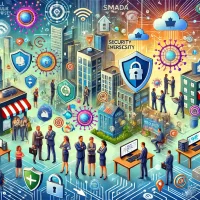Despite the challenges wrought by the COVID era, the ASEAN region’s economies have continued to rapidly grow, and technology is fueling that growth. Few areas in the world are experiencing change at the same pace. To take a single example at random, the region’s increased acceptance of electronic payments (as opposed to credit cards or cash) makes it stand out when compared to some of even the world’s biggest economies.
With fast growth comes an accompanying expansion of the digital attack surface preyed upon by cybercriminals. Failure to protect an organization’s assets (typically, its underlying technologies in the form of hardware and software) can stop growth in its tracks, cause massive development setbacks, or put a company right out of business. Even a mild attack can damage a company’s image — and in a highly connected, online multinational community, a poor reputation is lethal.
However, thriving business growth and iron-clad cyber protection can travel in parallel. At Tech Wire Asia, we spoke to Alvin Tan, Regional Vice President for Tanium, about the specific challenges of securing against threats in the ASEAN region, what sets Tanium’s offerings apart, and what businesses can and should expect from their cybersecurity partners.
“One of the gaps we see frequently,” he began, “is that if the business is on a run, the business leaders are running faster than the technical people in it.” That dynamic underpins the region’s reputation for coming up with some of the most disruptive and innovative ideas on the tech scene at present. But invention also requires safety. “It tends to be that applications are well thought out, but the cybersecurity around [them]…isn’t!”
As well as new services and applications hitting the market, businesses are also setting up branches in other APAC countries. That activity can stretch the capacity of the IT function to provide protection quickly, and at the correct time. “When you digitalize, you try to do more, and use automation as much as possible, use less human resources — try to use the computer to do more and more,” says Tan.
So how does the Tanium solution protect users’ computers, phones, and other connected devices differently and more quickly versus legacy anti-virus software? There’s a big clue uncovered when installing the agent. Tanium places a lightweight application (or agent) on each connected device, one that, critically, doesn’t require a reboot on installation or update. The agent allows for extremely fast communication between the server and all endpoints, creating an immediate visibility that was previously unavailable.
This is a significant differentiator from other solutions. Traditionally, such security agent code needs to hook into the core –literally, the kernel — of each machine, hence the required reboot. However, that approach means that users can interrupt updates, or corrupt the agent, by switching off the power mid-install or patch. There’s an increased likelihood, too, of the integrated agent being incompatible at a core level with the applications and services already running on the endpoint, or ones that may end up being installed further down the line.
Tanium’s agent reports to the central console (more on that shortly) very quickly. By examining the network in which it’s present, it can keep the endpoint protected and also flag the presence of other devices that might be present on the LAN, but do not yet have an agent of their own.
For that continuous ability to keep tabs on every endpoint as it moves from office to home to coffee shop, the Tanium platform provides a single “pane of glass,” which acts as the central point of oversight. With reactions and results (negative or positive) as to the health of every endpoint reported in close to real-time, companies in the ASEAN region can let their cybersecurity teams keep pace with the speed of business expansion.
Click here to view original web page at techwireasia.com








